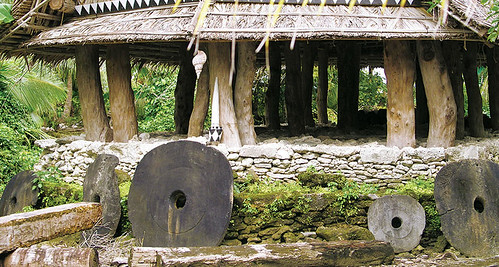
PREV ARTICLE
NEXT ARTICLE
FULL ISSUE
PREV FULL ISSUE
ECONOMISTS VS. ETHNOLOGISTS ON THE ORIGIN OF MONEYLarry Lee writes: This week's issue of Science News has two articles of the origins of money, both taken from a symposium in April sponsored by the Society for American Archeology. The two articles are "Conflict reigns of the history and origins of money" and "How an ancient stone money system works like cryptocurrency". Make sure to read both the bibliography and the comments section as well as the articles. The articles outline two viewpoints on the origin of money: one from the economists and one from the ethnologists. Guess there was no reason to ask the opinion of the numismatists. Thanks. Here are excerpts from each. Interesting theories, at least. The snarky comments of academics dissing one another are amusing. -Editor  How an ancient stone money system works like cryptocurrency Ownership of a disk could be transferred, for instance, as a wedding gift, to secure political allies or in exchange for food from residents of nearby islands after a severe storm. These deals also occurred in front of the whole community. No matter who acquired a rai, it stayed in its original location. Bitcoin and blockchain work in much the same way, Fitzpatrick says. Bitcoin “miners” solve complex mathematical puzzles to release units of currency. Those units are transported and securely stored across the public blockchain ledger. Full transaction histories for each bitcoin are available to all network participants. Bitcoins can be exchanged for goods or services or given away at any time by participants in the digital system. To read the complete article, see: Conflict reigns over the history and origins of money Economists and revisionists alike agree that an object defined as money works in four ways: First, it serves as a means for exchanging goods and services. Currency enables payment of debts. It represents a general measure of value, making it possible to calculate prices of all sorts of items. And, finally, money can be stored as a wealth reserve. From there, the two groups split. Mainstream economists assume that bartering of goods and services inspired money’s invention. Anthropologists and archaeologists contend that early states invented currency as a means of debt payment. To read the complete article, see:  Wayne Homren, Editor The Numismatic Bibliomania Society is a non-profit organization promoting numismatic literature. See our web site at coinbooks.org. To submit items for publication in The E-Sylum, write to the Editor at this address: whomren@gmail.com To subscribe go to: https://my.binhost.com/lists/listinfo/esylum All Rights Reserved. NBS Home Page Contact the NBS webmaster 
|